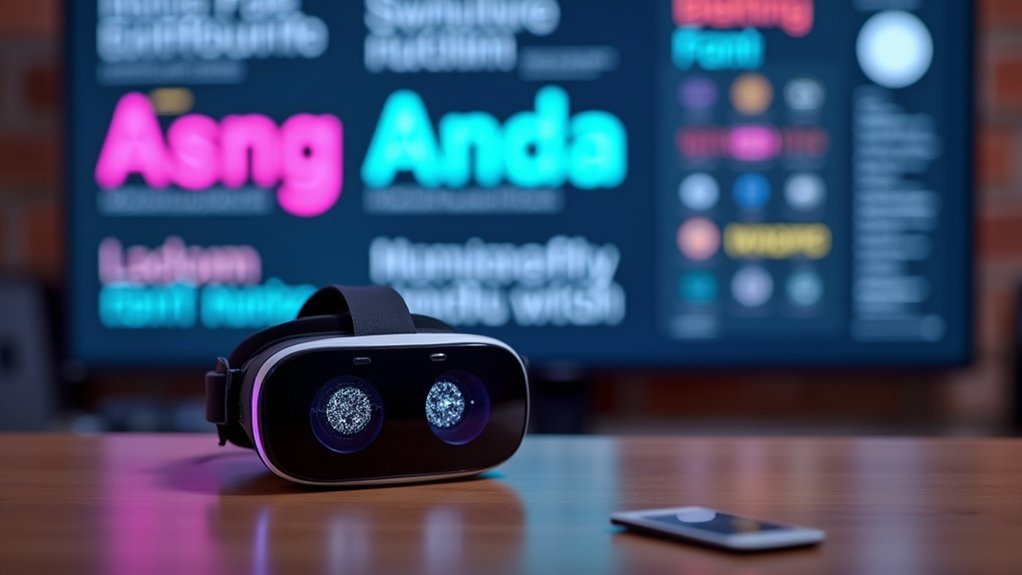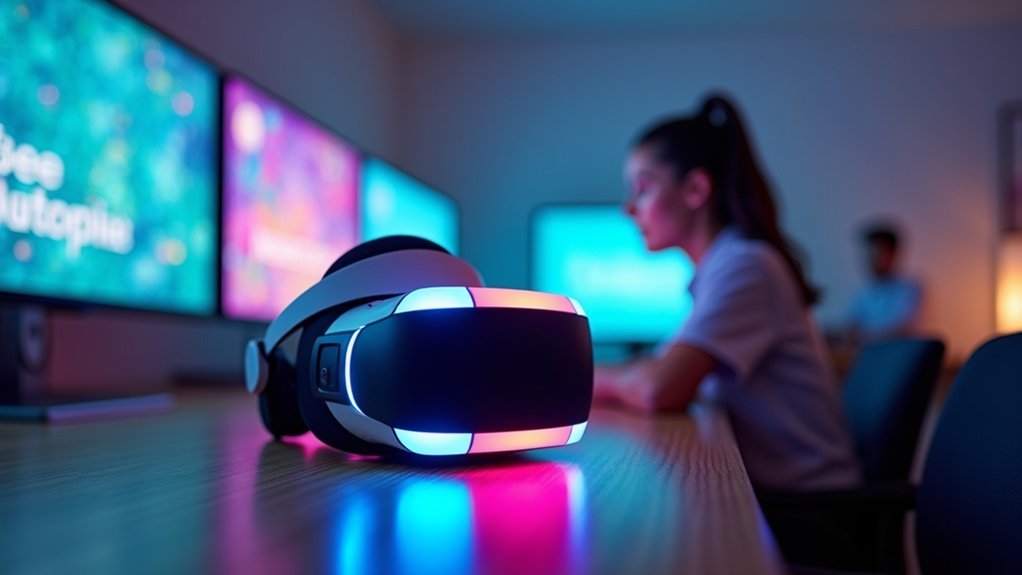You can enhance your VR experience with powerful cognitive accessibility tools including text-to-speech integration that transforms written content into spoken guidance, speech-to-text functionality for hands-free commands, and customizable font settings for improved readability. Real-time captioning provides instant transcription of audio content, while simplified interfaces reduce mental fatigue through intuitive design. Memory aid systems, alternative input methods like eye-tracking, and AI-powered adaptive learning environments complete this essential toolkit that’ll transform how you navigate virtual worlds.
Text-to-Speech Integration for Enhanced Navigation

When you’re maneuvering a virtual reality environment, text-to-speech integration transforms written content into spoken words, providing essential auditory feedback that enhances accessibility for users with visual impairments or cognitive disabilities.
This technology offers vocal prompts for menu options, settings, and instructions, considerably reducing cognitive load during navigation and interaction.
You’ll find that text-to-speech improves comprehension and engagement, particularly for individuals with learning disabilities, making VR experiences more enjoyable.
Customizable speech settings allow you to adjust speed and voice selection, tailoring auditory feedback to your preferences.
These accessibility features work seamlessly alongside other tools like speech-to-text functionality, creating an inclusive user experience that guarantees smooth navigation for all users in virtual environments.
Speech-to-Text Functionality for Voice Commands
Speech-to-text functionality revolutionizes how you interact with VR environments by converting your spoken words into actionable commands, eliminating the need for complex hand gestures or controller manipulation.
This technology employs advanced natural language processing algorithms to accurately translate your voice commands into text, enabling seamless navigation through virtual spaces. You’ll find that modern VR platforms integrate this accessibility feature, allowing you to control menus, issue directives, and communicate without physical controllers.
For users with cognitive and motor impairments, speech-to-text functionality creates more inclusive immersive experiences. You can interact faster through voice commands than traditional input methods, leading to increased engagement and satisfaction.
Research demonstrates that this accessibility tool greatly improves user experience, making virtual environments more welcoming for individuals with diverse abilities and promoting universal access to VR technology.
Customizable Font and Display Settings

You’ll find that customizable font and display settings form the foundation of accessible VR text presentation.
These controls let you adjust font size to match your visual needs while fine-tuning color contrast between text and backgrounds for ideal readability.
You can also modify text spacing options to reduce visual crowding and improve comprehension in immersive environments.
Font Size Adjustment
Although VR environments can present unique reading challenges, customizable font and display settings offer essential accessibility solutions that adapt to your visual and cognitive needs. Font size adjustment stands as a fundamental feature that transforms how you interact with virtual content.
When you can modify customizable font sizes, you’ll reduce cognitive load and improve comprehension. These accessibility options prove especially valuable if you have visual impairments or cognitive disabilities, allowing you to personalize your VR experience completely.
| Font Size | Best For | Benefits |
|---|---|---|
| Small (8-12pt) | Standard vision users | Screen space maximization |
| Medium (14-18pt) | Mild vision difficulties | Balanced readability |
| Large (20-24pt) | Notable visual needs | Enhanced clarity |
Research shows that adjustable text sizes considerably boost user engagement and learning outcomes across diverse cognitive abilities.
Color Contrast Controls
When you customize color contrast controls in VR environments, you’ll dramatically improve readability and reduce visual strain that often accompanies prolonged virtual experiences.
These controls are essential for users with cognitive disabilities and visual impairments, as they enable personalized viewing preferences that enhance comprehension and navigation.
You can implement customizable color schemes that include high contrast modes and light/dark theme options.
Since up to 8% of men and 0.5% of women experience color vision deficiencies, these features guarantee broader accessibility.
When developing VR applications, you should utilize tools like WCAG Contrast Checker to verify that all text and interactive elements meet accessibility standards.
This empowers users to engage more effectively with content according to their unique visual needs.
Text Spacing Options
Beyond color adjustments, text spacing options give you thorough control over how written content appears in your VR environment.
You’ll find these settings particularly valuable when managing cognitive load and improving readability. When you modify character spacing, you’re preventing text crowding that can overwhelm users with dyslexia or other reading difficulties.
These customizable font options work alongside adjustable text size to create ideal viewing experiences for individuals with visual impairments. You can increase letter spacing, adjust line height, and modify word gaps to match your specific needs.
VR accessibility benefits greatly from these granular controls, as they reduce cognitive strain during extended sessions. By fine-tuning text spacing options, you’re creating a more inclusive virtual environment that accommodates diverse reading preferences and neurological differences.
Real-Time Captioning for Audio Content

Since virtual reality environments rely heavily on audio cues and spoken dialogue, real-time captioning becomes vital for creating truly inclusive experiences. You’ll find that technologies like AirCaption deliver immediate text representation of spoken content, directly addressing accessibility needs for users with hearing impairments.
| Feature | Benefit | Impact |
|---|---|---|
| Live transcription | Immediate text display | Enhanced comprehension |
| Speaker identification | Clear dialogue attribution | Better context understanding |
| Sound descriptions | Background audio context | Complete audio awareness |
| Multi-language support | Global accessibility | Broader user inclusion |
| WCAG integration | Standards compliance | Legal requirements met |
These tools transform immersive experiences by ensuring you don’t miss essential audio information. Real-time captioning also supports compliance with accessibility standards, making your VR content legally compliant while boosting engagement across diverse user groups.
Simplified User Interface Design
You’ll find that intuitive navigation systems in VR environments reduce the mental effort required to understand and interact with virtual spaces.
When you’re presented with simplified menu structures and predictable interaction patterns, you won’t struggle to remember complex sequences or decipher confusing interface elements.
This streamlined approach helps you focus on your primary tasks rather than wrestling with unnecessarily complicated controls.
Intuitive Navigation Systems
When traversing virtual reality environments, you’ll find that intuitive navigation systems serve as the foundation for truly accessible experiences. These systems enhance cognitive accessibility by implementing clear icons, straightforward menus, and logical pathways that reduce mental strain.
You’ll benefit from consistent visual cues and familiar layouts that help you locate essential features quickly without confusion.
The most effective user interface design incorporates customizable controls, allowing you to adjust complexity based on your comfort level. You can personalize your experience by modifying navigation elements to match your cognitive needs.
Additionally, guided tutorials and contextual tooltips provide real-time assistance, helping you understand functionalities as you explore. Research shows these simplified approaches improve engagement and retention rates, creating more welcoming digital environments for users with varying cognitive capabilities.
Reduced Cognitive Load
While complex interfaces can overwhelm users with cognitive disabilities, simplified user interface design transforms VR environments into manageable spaces that prioritize essential functions over decorative elements. You’ll experience reduced cognitive load when developers minimize clutter and focus on what truly matters for navigation and interaction.
Clear labeling and intuitive icons help you quickly understand each function without guessing or memorizing complex symbols. Predictable navigation patterns let you build familiarity, making each VR session more comfortable than the last.
| Design Element | Cognitive Benefit |
|---|---|
| Larger fonts for key information | Guides attention effectively |
| Distinct color coding | Streamlines decision-making |
| Consistent layout patterns | Aids memory retention |
| Concise instructions | Prevents information overload |
This approach guarantees you’ll stay engaged without feeling overwhelmed.
Cognitive Load Reduction Features
Since cognitive disabilities can make information processing particularly challenging, cognitive load reduction features serve as essential tools that simplify complex VR interactions and minimize mental strain.
These features enhance cognitive accessibility by providing clear instructions and straightforward navigation that eliminate confusion during your VR sessions.
You’ll benefit from customizable controls that let you adjust settings according to your specific needs, reducing mental fatigue while accessing content.
Visual aids like simplified icons and graphics communicate information without overwhelming you, while auditory cues and haptic feedback help confirm your actions and decisions.
These cognitive load reduction mechanisms work together to create an intuitive experience that supports your understanding and engagement, making VR technology more accessible and enjoyable for users with diverse cognitive abilities.
Memory Aid and Reminder Systems
Beyond reducing cognitive load, VR memory aid systems actively support your ability to retain and recall important information through interactive visual elements and personalized reminders.
These systems integrate alerts directly into your VR environment, prompting you about tasks and events to enhance daily activity management. You can customize virtual sticky notes and 3D reminders to match your specific needs and preferences.
If you have cognitive disabilities, these immersive environments can improve your memory recall by up to 30% by engaging multiple senses simultaneously.
VR applications incorporate gamification techniques that make memory tasks more enjoyable and motivating, increasing your engagement and retention.
These interactive memory aids transform challenging cognitive tasks into accessible, personalized experiences.
Alternative Input Methods for Motor Accessibility
When traditional VR controllers become barriers rather than gateways, alternative input methods transform virtual environments into accessible spaces for users with motor impairments.
Voice commands let you navigate and interact without physical controllers, providing seamless hands-free control. Eye-tracking technology enables gaze-based navigation, allowing you to control environments through natural eye movements. Gesture recognition systems interpret your hand and body movements as input, creating intuitive interactions even with limited mobility.
Adaptive controllers offer customizable layouts and sensitivity settings that accommodate your specific physical abilities. Tools like WalkinVR Driver translate real-world wheelchair movements into virtual actions, ensuring broader accessibility.
These motor accessibility solutions eliminate physical barriers, empowering you to engage fully in VR experiences regardless of your motor capabilities or mobility limitations.
Multi-Modal Communication Options
How do you guarantee everyone can communicate effectively in virtual reality environments regardless of their sensory or motor abilities? Multi-modal communication options provide the solution by offering diverse interaction pathways.
You’ll benefit from text-to-speech and speech-to-text features that convert written words to spoken dialogue and vice versa, supporting users with disabilities who face visual or auditory challenges. On-screen chat boxes and messaging systems accommodate those preferring typed communication over verbal interaction.
Captions for all spoken content, music, and audio cues assure hearing-impaired users don’t miss critical information.
Customizable user interfaces let you adjust font types, sizes, and colors to match your visual needs. Multiple input methods, including hand tracking and Bluetooth keyboard support, enable comfortable interaction regardless of your physical abilities or preferences.
AI-Powered Adaptive Learning Environments
When you enter an AI-powered adaptive learning environment in VR, you’re experiencing technology that creates personalized learning pathways based on your unique cognitive profile and learning preferences.
The system continuously monitors your interactions and adjusts content difficulty in real-time, ensuring you’re neither overwhelmed nor under-challenged as you progress through educational material.
You’ll find that these intelligent environments respond to your pace and comprehension levels, making learning more accessible and effective for your specific cognitive needs.
Personalized Learning Pathways
AI-powered adaptive learning environments represent a transformative approach to cognitive accessibility in virtual reality education.
These immersive virtual systems create personalized learning pathways by analyzing your interactions to identify strengths and weaknesses. You’ll experience content that adapts in real-time to match your unique cognitive profile, ensuring ideal comprehension and engagement.
Adaptive technologies within these environments reduce cognitive overload, allowing you to progress at your own pace while reinforcing concepts effectively.
The inclusive design accommodates various learning styles and challenges faced by individuals with cognitive disabilities. You’ll benefit from enhanced retention and improved educational outcomes as the system continuously adjusts difficulty levels, presentation methods, and pacing.
This approach transforms traditional one-size-fits-all education into truly personalized experiences that maximize your learning potential.
Real-Time Difficulty Adjustment
As you navigate through virtual learning experiences, sophisticated algorithms continuously monitor your performance and automatically recalibrate content difficulty to match your cognitive capacity. Real-time difficulty adjustment guarantees you’re neither overwhelmed nor under-challenged, creating ideal learning conditions tailored to your specific needs.
These AI-powered systems excel at serving diverse user needs by analyzing your interactions and responses. When you struggle with complex concepts, the system immediately simplifies presentations and provides additional support. For learners with cognitive disabilities, this adaptive learning approach proves particularly valuable, offering personalized feedback that enhances comprehension while maintaining engagement.
| Feature | Benefit |
|---|---|
| Dynamic Task Complexity | Prevents frustration and boredom |
| Performance Analytics | Identifies learning patterns instantly |
| Accessibility Integration | Supports simplified text and visual aids |
| Outcome Improvement | Increases learning effectiveness by 30% |
Frequently Asked Questions
How to Make VR Accessible?
You’ll need to implement clear navigation, add speech-to-text features, provide customizable text options, reduce cognitive load through intuitive design, and include thorough captions for all audio content throughout your VR experience.
What Are Accessibility Tools?
You’ll find accessibility tools are software features and hardware adaptations that help people with disabilities use technology more effectively. They remove barriers, enabling you to navigate, interact, and access digital content regardless of your abilities.
What Are the Sensory Devices Used in Virtual Reality?
You’ll encounter haptic feedback gloves for tactile sensations, eye-tracking technology for gaze navigation, spatial audio systems for three-dimensional sound, adaptive controllers with customizable layouts, and emerging brain-computer interfaces for neural control.
What Are the Features of VR Accessibility?
You’ll find VR accessibility features include captions, audio descriptions, adjustable avatar heights, voice commands, gesture recognition, high contrast modes, customizable text sizes, simplified navigation, clear instructions, and thorough user education materials.





Leave a Reply